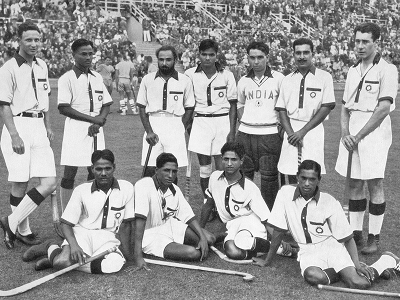
Community set the foundations for the game here. And it was their post-Independence exodus to Australia that built up the sport in that ex-colony.
Every four years, a billion-plus Indians pray that our hockey team should win a medal at the Olympics, as it has done eleven times before. This year the Indian team does, indeed, stand a chance. But, let’s face it, India’s ‘Golden Age’ of hockey is long gone.
That Golden Age was between 1928 and 1956. Some pundits, however, would narrow it down to the period 1928-1936, when India, in its first three Olympics, annihilated all opposition, with the incredible goal ratio of 97:3, thus acquiring the reputation of being “magicians with hockey sticks”. It’s an era we automatically associate with the legendary Dhyan Chand. But it’s strange that many of us know nothing about the large number of Anglo-Indian hockey stars without whom it wouldn’t have happened.
A quick glance at the numbers says it all: At the 1928 Olympics, eight of the Indian XI were Anglo-Indians; at the 1932 Olympics seven of the Indian XI were Anglo-Indians; at the 1936 Olympics six of the Indian XI were Anglo-Indians. But, as Frank Anthony, an Anglo-Indian leader of the time remarked, the hockey talent of this little community ran so deep that it could have perhaps produced six times those numbers of world-class players.
Hockey maestros like Carlyle Tapsell, Broome Penniger, Richard Allen, Dickie Carr, Leslie Hammond, the Goodsir-Cullen brothers and Joe Galibardy — now long-forgotten — all played a key role in India’s dominance of the game. If Dhyan Chand was “the world’s greatest centre forward”, Broome Penniger was the world’s greatest centre-half and Richard Allen was the world’s greatest goal-keeper (allowing only two goals through all the Olympic games of 1928, 1932 and 1936, an amazing record). The other Anglo-Indian stars were not far behind in their prowess, combining a high degree of artistry with a robust aggressiveness.
So what was the reason for this domination of hockey by the Anglo-Indians — who, after all, accounted for only about 0.1% of India’s population at the time?
The answer lies in the fact that the game came to India with the British army in the 1880s. While the officers played cricket and polo, the ordinary British soldier preferred the rugged game of hockey. The soldiers first played between themselves, and then they began to play with teams raised from local organisations, like the railways, police and port authorities — all of which employed significant numbers of Anglo-Indians. Soon, hockey was embraced by the Anglo-Indian community as an embodiment of masculine virtue, and it became an integral part of the Anglo-Indian culture: every family pushed their sons to excel at the game.
It started in Bengal and by 1895 Kolkata had a number of great Anglo-Indian hockey teams, who battled each other in the newly instituted Beighton Cup Tournament: legendary teams like Calcutta Naval Reserve, Calcutta Rangers, Bengal-Nagpur Railways and Calcutta Customs. In time, leading teams from Mumbai, Lahore, Jhansi and other parts of India joined the fray. Thus, by the time India was officially admitted to the Olympic Games in 1928, there was such an abundance of hockey-playing talent in the country that choosing only 15 players for the contingent posed a problem. Interestingly, Britain, who’d been the hockey champions in the two previous Olympics, quietly withdrew their team at that point — presumably to avoid humiliation from their colonial subjects. They would stay away from Olympic hockey until the end of the Raj.
Meanwhile, Anglo-Indian players played a decisive role in India’s Olympic hockey triumphs in 1928, 1932 and 1936. And if World War II hadn’t intervened, they would have, doubtless, continued to do so in 1940 and 1944, as well. But after 1947 there was an exodus of Anglo-Indians, and this, obviously, affected Indian hockey significantly. The Indian contingent for the 1948 Olympics in London still included seven Anglo-Indians (it would have been eight, but Joe Galibardy, that brilliant left-half, had to drop out for personal reasons). But by 1952, there were only two Anglo-Indians left in the Indian contingent.
India’s loss proved, however, to be Australia’s gain. The Anglo-Indian diaspora settled mainly in Western Australia, and created a powerful hockey culture in the state. Soon the Western Australia team began to dominate Australian hockey. And that was the beginning of Australia’s emergence as a world hockey power — driven by Anglo-Indian coaches and players, like Trevor Vanderputt, Fred Browne, Merv Adams, Dickie Carr, the five remarkable Pearce brothers, Kevin Carton and Paul Gaudoin. In the 1956 Melbourne Olympics, when India played against Australia, there were five Anglo-Indians on the field — four of them on the Australian side, and only one on the Indian side. And in the 1960 Rome Olympics when India played against Australia, the rival captains in that closely-fought match, Leslie Claudius and Kevin Carton, were both, ironically, Anglo-Indians. Meanwhile, another great Anglo-Indian player, Rex Norris, was masterminding the emergence of the Netherlands as another major world hockey power.
Leslie Claudius, arguably the greatest of the Anglo-Indian players, saw India through to the end of its Golden Age, which culminated in its defeat to Pakistan in the 1960 Olympics. When he died in Kolkata in 2012, largely forgotten, it was the end of an era. In the Rio Olympics, the top-ranked teams are (in ascending order) India, Britain, Germany and the Netherlands. The No 1 ranked team, however, is Australia. There’s probably a moral in this story, somewhere.
The writer is an advertising professional and hockey buff.
source: http://www.timesofindia.indiatimes.com / The Times of India / News Home / by Anvar Alikhan / TNN / August 14th, 2016